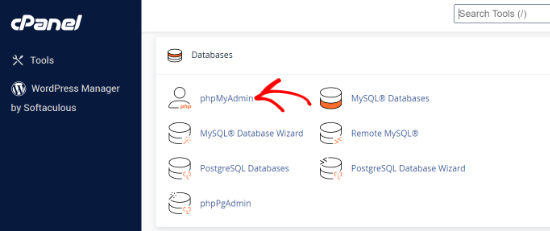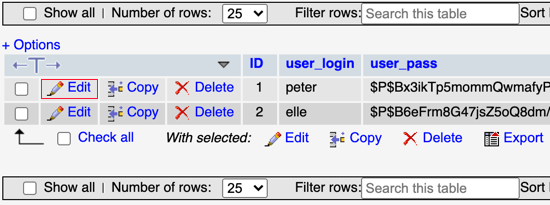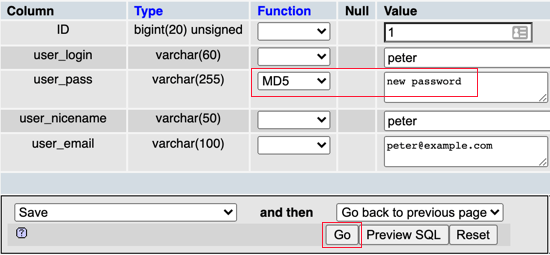Resetting your WordPress password is usually a straightforward process. However, sometimes the standard methods don’t work, leaving you locked out of your website.
Some of our readers have encountered this issue and asked for our advice about the best way to access their accounts. Luckily, you can always use the phpMyAdmin tool in your hosting account’s control panel to directly reset your password from the WordPress database.
In this article, we will show you how to easily reset a WordPress password from phpMyAdmin. We’ll explain each step clearly, ensuring that even if you’re not familiar with databases, you can follow along safely.

Why Reset a WordPress Password From phpMyAdmin?
WordPress makes it super easy to recover a lost password.
You can simply go to the login screen of your WordPress website and click on the ‘Lost your password?’ link.

When you click on the link you are taken to the password reset page. Once you enter your username or email address, WordPress will send a password reset link to the associated email address.
However, if you don’t have access to that email address, or your WordPress site fails to send an email, then you will not be able to reset your password.
In such a situation, you will need to reset your WordPress password directly in the database. The easiest way to do that is by using phpMyAdmin.
Having said that, let’s see how you can easily reset a WordPress password from phpMyAdmin.
How to Reset a WordPress Password From phpMyAdmin
If you don’t want to watch the video tutorial, then you can continue reading the text version below.
First, you need to log in to the cPanel dashboard of your WordPress hosting account. Next, you need to navigate to the Databases section where you can click on the phpMyAdmin icon.

This will launch the phpMyAdmin app.
Here you need to select your WordPress database from the left pane.

You will now see the list of tables in your WordPress database.
You need to look for the wp_users table in this list and click on the ‘Browse’ link next to it.

Note: Table names in your WordPress database may have a different prefix than the one we are showing in our screenshot. Changing table prefixes can improve the security of your WordPress site.
You will now see the rows in your WordPress users table. Go ahead and click on the edit button next to the username whose password you wish to change.

PhpMyAdmin will show you a form with all the user information fields.
You will need to delete the value in the user_pass field and replace it with your new password. Under the function column, select MD5 from the drop-down menu and then click on the Go button at the bottom of the form.

Your password will be encrypted using the MD5 hash and then it will be stored in the database.
Congratulations! You have successfully changed your WordPress password using phpMyAdmin.
Some of you may be wondering why we selected the MD5 hash to encrypt the password. WordPress previously used MD5 hash to encrypt passwords, but since WordPress 2.5 it has been using stronger encryption technologies.
However, WordPress still recognizes MD5 to provide backward compatibility. As soon as you log in using a password string stored as an MD5 hash, WordPress will automatically change it to use the newer encryption algorithms.
Expert Guides on Passwords in WordPress
Now that you know how to reset a WordPress password from phpMyAdmin, you may wish to see some other articles related to passwords in WordPress.
- How to Change Your Password in WordPress (Beginner’s Guide)
- How to Reset Passwords for All Users in WordPress
- How to Customize the WordPress Reset Password Page
- How to Force Users to Change Passwords in WordPress – Expire Password
- Forgot Password? How to Recover a Lost Password in WordPress
- How to Force Strong Passwords on Users in WordPress
- How to Add Two-Factor Authentication in WordPress (Free Method)
- How to Allow Users to Hide/Show Passwords on WordPress Login Screen
- How to Easily and Securely Manage Passwords (Beginner’s Guide)
We hope this tutorial helped you learn how to reset a WordPress password from phpMyAdmin. You may also want to see our ultimate step-by-step WordPress security guide to keep your WordPress site safe or our expert pick of must-have plugins.
If you liked this article, then please subscribe to our YouTube Channel for WordPress video tutorials. You can also find us on Twitter and Facebook.





Bowen
Hello,
Added Https to all pages, says unsafe, attempt to login and no luck, hit forgot password system reverts to Mojo Page…changed password per instructions above still no luck…any ideas how to get https off wordpress?
Tess
OK, I have followed these instructions and successfully changed my admin password in the database and I still get a failed login message when I login with it. I need help gaining access to my site, please.
Sandra
Thank you so much! These instructions helped me reset my WP username and password
neotanvir
How can I transfer MD5 to normal text
Patty Ayers
Thank you! Worked like a charm.
Edwin Schichter
Very simpel…. just change and save the users emailadress into something familiar in the database, click on forgot password in the wordpress login page
Patty Ayers
Yes, but only if you already have access to the back end.
Andrew
Awesome thanks so much for taking the time to write this just recovered by site in 60 seconds – as a newbie rely on help online :)))
Yana
Thanks mate, you made my day =)
Kinfe Weldu
thank you.this solved my problem.
sarah
thanks very helpful
Toyin
Thanks for this article.Simple guide,was able to change my password through myphp.
harish chand
Great thanks
MITESH MISTRI
Hey… Nice post and this idea really works. Thanks.
Adeel Ahmed
Thanks a lot. I had the problem but it has been solved . Otherwise I felt miserable about my wordpress login password being stolen
Jedediah
Odd, I did this correctly and it’s still not letting me in.
venukanth
really thanke ..most use full
Hasan
Thanks, it’s really helpful and great !!
Razzaq
another simple method for get the password, after edit the record change the email address. On wp-admin login screen, click on forget password. You will get the new link of make a new password.
Harsh
Thanks a lot friend, very helpful post
Asaf Fialkov
Many thanks! Worked like a charm
Mike
Fantastic, you are geniuses!
Ken
Thanks Man, your a lifesaver
Dave
Perfect. Thanks for posting.
VaLAngel
Great, great, great! 1 Billion Thanks…
Clinton
Thank you!
Al
Thanks buddy, i used to do lots of stuff on my wordress blog few years ago but now i kind of forget how to do it. Your blog post refreshed my memory…thanks again
Jarrii
Thank you so much It works perfectly
It works perfectly 
Hilda
worked perfectly, thank you so much!
Dan
Followed your very clear steps. Worked like a charm. THANK YOU!
Rose
Thank you so much! I couldn’t get into my new install of Word Press and of course it is the weekend. This is so well written that I was able to reset the admin password in one try.
Ewan
How is this discussion affected by the salts in the wp-config file? Do we need to combine those when creating a new password?
Marty
Over the last few weeks, I’ve had the pleasure of dealing with clients that didn’t have a reputable developer/designer and left them high and dry with little to no access of their OWN site, noway of re-setting the password through the recovery email, this guide WOULD have been great 2 weeks ago, but I’m sure I’ll be using it in the near future…
cheers Syed..
Karl Craig-West
Perfect, worked a treat.
Many thanks indeed.
Harpa
Thank you so much
Dotty
Thanks so much – this really helped.
Luis
What a lifesaver post! Thanks!
Ton
Thank you so very much!
Andrea
ok, I have done step by step everything you have suggested and is not working……..what can I do?
Editorial Staff
Theoretically, if you did everything mentioned in this article, then it should work. However, you can always try this tutorial where you add a new admin user.
https://www.wpbeginner.com/wp-tutorials/how-to-add-an-admin-user-to-the-wordpress-database-via-mysql/
Admin
Marty
You can lead a horse to water………..but…..!…..
BK
This was a life save. thanks
vking
thanks you man it’s work!
it’s work!
Muhammad Abdul Qadoos
why not we change email address and ask wp to resend password reset email
we change email address and ask wp to resend password reset email 
Editorial Staff
You can do that as well. Then go click on reset button. Wait for the email to come. Then reset your password. Seems like a bit longer process, but to each their own.
Admin
subbareddy
this helps very much when you are in local system . Password reset doesnt work some times in local server .
I helped me a lot today
Benjamin
Some hosts have the mail() function turned off and are unable to send emails via php.
stevelockridge
Fabulous!!! Thank you!!! My client contacted me because their previous designer vanished and left them with NO login information for ANYTHING. This saved us all a lot of headaches.
rradvani
great saved me !!! thanks wpbeginner!!
!!! thanks wpbeginner!!
sharphue
See that user_email field in the screenshot above? Just change the value to an e-mail address that you have access to. On the WP-Admin login screen, click “lost your password?” and type in the same e-mail address and you will receive a reset password link that will be easier than messing with MD5 hashing.
Oluniyi D. Ajao
Thank you very much. You saved me having to re-install a WordPress installation.
W^L+
There has been some talk about web applications moving to a hash of the password + another string, to make it harder for bad guys to get in. Do you think this is coming to WP soon? (I think Joomla and Drupal are already doing this.)
Editorial Staff
WordPress already has that built-in. You just have to add your own security keys in your wp-config.php file. Open it and you will see the place for it and a link where you can get your security keys from.
Admin
Jeff
Under the functions column, if you choose MD5, MySQl will automatically encrypt your password in MD5. Simply type your plaintext password in the main box.
This is a little easier than using other sites.
kusanagi
very helpful, thanks.
Utkarsh
You can also enter the password in plain text, and select MD5 from the function dropdown. It’ll automatically save the MD5 hash of the password in the database.
Jaspal
Thnx .. that’s a great tip .. it will be very helpful for me